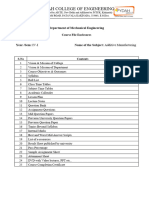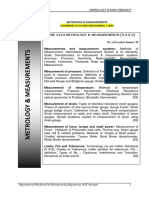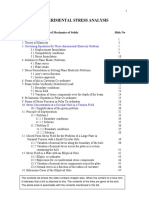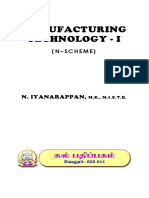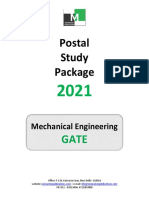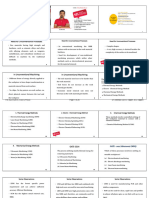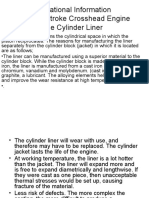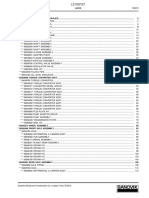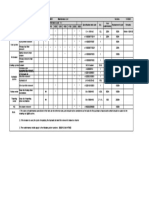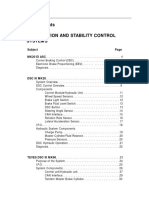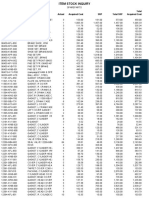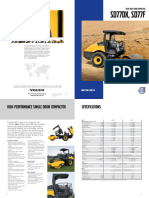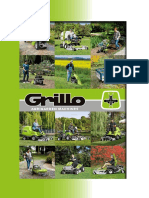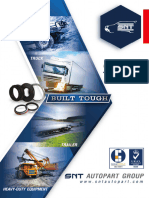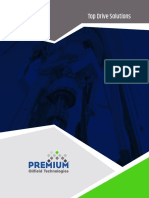Tractors - Unit I
Uploaded by
srinivasan ssmietTractors - Unit I
Uploaded by
srinivasan ssmietAI 3401 TRACTORS AND ENGINE SYSTEMS
AI 3401 TRACTORS AND ENGINE SYSTEMS
UNIT I NOTES
ROHINI COLLEGE OF ENGINEERING AND TECHNOLOGY
AI 3401 TRACTORS AND ENGINE SYSTEMS
Cylinder Block:
This is the main support for all other basic engine parts. The crankcase and
cylinder blocks are often cast in one piece. This is the largest and heaviest single
piece of metal in the engine. When the cylinder blocks are cast in one piece it is
designated as cast block or mono block engine. It is cast from gray iron or iron
alloyed with other metals such as nickel or chromium. Some blocks are cast in
two separate parts, i.e., the crankcase and block are cast separately and then
bolted together. Sometimes, the crankcase is made of aluminium alloy and the
cast iron block is bolted to it. In other cases, the aluminium block has an iron
cylinder line cast into the die cast block.
The casting for the engine block is normally intricate. This is because it contains not only
the engine cylinders but the water jackets that surround them as well. In addition,
passage ways are provided to accommodate the valve mechanism and openings for inlet
and exhaust ports. The lower part of the cylinder block contains supporting bearings for
the engine crankshaft. The upper halves of the crankshaft or main bearings are assembled
directly into half-round sections in the cylinder block. The lower halves of the main
bearings are held in place by bearing caps attached to the cylinder block by bolts.
The camshaft is supported in the block by bushings that fit into machined holes in the
block. The intake and exhaust manifolds are attached to the side of the cylinder block on
L-head type engines. In 1-head engines, the manifolds are attached to the cylinder head.
ROHINI COLLEGE OF ENGINEERING AND TECHNOLOGY
AI 3401 TRACTORS AND ENGINE SYSTEMS
The other parts attached to the block include the water pump, timing gear/chain,
flywheel and clutch housing, fuel pump, filters, etc. The cylinder head is mounted on the
top of the block. These parts are attached to the block with sealing gaskets.
Cylinder Liner:
This is an integral part of the cylinder. It fits inside the cylinder block. The liner must
have the following characteristics:
1. Its material must withstand working temperature and pressure.
2. Maximum heat dissipation with minimum time and wear.
3. It should possess lubricating properties or it should be self-lubricant.
4. Maximum hardness with maximum flexibility.
5. Resistance due to corrosion and wear.
6. Minimum permanent change in dimensions
7. High durability.
8. Low cost.
Materials for Cylinder:
Materials used for a cylinder and cylinder liners, are: (1) close grained cast iron and (f)
nickel cast iron
The wear on the liners can be substantially reduced if their inner surface is made harder
by any of the following three methods:
Method I: This is applied to dry liners and use cast iron with 2% nickel and 0.65%
chromium. After preliminary machining, the liners are heated in an oven furnace to about
840°C, oil quenched and tempered for 2 hours at 180°C. The wear of such liners hardness
of 230-240 Brinnel is about one-third that of an alloy cast iron cylinder having a hardness
scale.
Method II: Cast Iron cylinders are heated from inside by high frequency induction
current to quench them with water. This gives a surface hardness of Rockwell 25-55. The
depth of hardness is 0.070" but the main body of the liner remains unchanged. After
tempering, the bore is honed and finished to the final size.
Method III: In this method, the inner bore of the liner is chrome plated electrically. This
gives it a very hard but porous surface. This type of surface helps the formation and
retention of a good oil film which results in an exceedingly low amount of wear. The
hardness of the liner by either of these methods reduces the wear of both the piston
surface and piston rings.
ROHINI COLLEGE OF ENGINEERING AND TECHNOLOGY
AI 3401 TRACTORS AND ENGINE SYSTEMS
Types of Liners:
Wet Type:
Such liners are broadly used in heavy duty diesel engines where cooling becomes
somewhat more difficult and complicated. These liners have direct contact with water
and are, therefore, called wet liners. The sealing of water is done by O-rings in the bottom
of the liner and flange on top. Such liners are usually classified either as push fit or semi-
fit.
Dry Type:
These are used mostly in petrol and air cooled engines where the heat developed is not
as much as in wet type liners. Some diesel engines also use dry type liners, viz. Perkins
engine.
Block-Casted Liners:
These liners have no direct contact with water. The liner is either press fitted or semi-
press fitted with the block. The water circulating inside the block first cools the block.
Then the block cools the liner. Thus the cooling of the engine is maintained.
Cylinder Wear:
Cylinder walls wear out regardless of how carefully they are designed or finished. This is
due to the side thrust on the piston in the cylinder and the pressure of the piston rings
against the cylinder walls. This wear occurs mostly in the area covered by the piston rings
ROHINI COLLEGE OF ENGINEERING AND TECHNOLOGY
AI 3401 TRACTORS AND ENGINE SYSTEMS
as they travel up and down in the cylinder. The cylinder also wears out-of-round because
of the side thrust of the pistons. This is due to the angular relationship between the
connecting rod and crankshaft. The pressure exerted on the piston is much greater in the
power stroke. As a consequence, the cylinder wears most on the power thrust side and
becomes out-of-round.
The wear is more at the top of the ring travel than at the bottom. The reasons for this are:
1. The cylinder and piston are hotter and exposed to more grit at the top than at the
bottom. Therefore, wear is accelerated.
2. There is more oil at the bottom ring and in the bottom of the cylinder than in the top.
This tends to reduce the friction at the bottom and consequently the wear.
The top unworn portion of the liner is known as ridge. This ridge must be cut before
installing a new ring set. Otherwise, during the upward motion of the piston, the sharp
edges of the ring will strike the rounded surface of the ridge. This can cause knocking
sound and also result in the breakage of the top ring or second ring land on the piston.
An excessive amount of out-of-round or taper in the cylinder walls makes it difficult to
maintain a tight seal between the piston and cylinder walls. Such cylinders should be
restored to a round condition with the walls parallel.
Cylinder Bore Inspection:
When the wear ridge is not deep enough it is possible to remove the pistons from the top
without removing the ridge. However, if the ridge is deep it must be cut before removing
the pistons.
Once the pistons are removed from the bore, the bore can be inspected for wear with the
help of a cylinder bore dial gauge. The bore should be checked for both taperness and
ovality. It is always a good practice to record the reading of the dial gauge, on a prepared
proforma so that a correct decision can be taken about re-ringing or re-boring depending
on the amount of taper and ovality.
Glaze Breaking:
During the operation of an internal combustion engine, a glaze is formed on the cylinder
walls by the combined action of combustion, lubricating oil and normal wear. Glaze
formation can be identified by the highly polished appearance of the cylinder walls when
the pistons are removed. This glaze should be removed before fitting new rings as the new
ROHINI COLLEGE OF ENGINEERING AND TECHNOLOGY
AI 3401 TRACTORS AND ENGINE SYSTEMS
rings installed in a glazed cylinder bore may take longer time for bedding- in and possibly
result in blow-by, scuffing and excessive oil consumption in the early stages of operation.
Waviness:
A wavy cylinder wall is one having a series of parallel lines or rings round the cylinders.
They are generally found at the top or bottom of the ring travel. These irregularities,
although immeasurable in most cases, can usually be felt by running a finger over the
cylinder surface.
Scuffing:
A scuffed cylinder is one in which the surface metals of the ring and cylinder wall reach
the melting temperature and cold-weld to one or more of the rubbing surfaces. As a result
of scuffing, metal is torn from one surface and deposited on the other, thug building up
material on one, leaving a small void in the other. If this pulled-out material is not removed
from the cylinder prior to the installation of new piston rings, the scuffing process can
continue. This can result in severe scoring of the bore and accelerated ring wear. A scuffed
cylinder can be identified by many small discoloured areas on its surface. They may be in
the shape of spots or vertical lines.
Honing:
The cylinder wall waviness and deposits resulting from scuffing can be only removed by
using a flexible spring loaded type hone. Pass the hone through the bore several times
until waviness and scuffing are removed and the desired finish is obtained.
CYLINDER HEAD:
Design:
The cylinder head is a separate cast piece which is bolted to the top of the cylinder block.
It encloses the top of the cylinder forming the combustion chamber. The head is sealed to
the cylinder with a flat gasket of copper and asbestos or steel and asbestos and is
tightened with cap screws or studs. In I-head and F-head engines the cylinder head
contains the valve and valve port openings that lead into the cylinders. The cylinder heads
for air cooled engines have fins which help to dissipate heat. In water cooled engines the
cylinder head has a passage cast integrally with the head. This enables the cylinder to be
entirely surrounded by water. Upward circulation of water is provided by the passages
between the cylinder and head to the radiator.
ROHINI COLLEGE OF ENGINEERING AND TECHNOLOGY
AI 3401 TRACTORS AND ENGINE SYSTEMS
Material:
The cylinder heads are mostly made of cast iron, gray iron, aluminium alloy or alloy steel,
with small percentages of chromium and nickel. Some cylinder heads are made of
aluminium alloy which has a higher heat conductivity than cast iron, as a result of which
it dissipates heat more rapidly.
Gasket:
The joints between the cylinder block and head must be tight and able to withstand the
pressure and heat developed in the cylinders. Head gaskets are made of sheets with
openings for cylinders, valves, water jackets, etc. When they are placed in position
between the block and head, tightening of the head bolts squeezes the soft metals
between the head and cylinder block and the joint is effectively sealed. Head gaskets are
made of plain copper, asbestos between two thin copper sheets or crimped steel. In the
last type, the crimping is flattened out as the head bolts are tightened. This produces the
sealing effect. As a rule, gaskets can be used only once. If they are removed and reinstalled,
they cannot be further compressed to provide effective sealing.
Removing Cylinder Head:
The engine should be cleaned before any repair or adjustment is to be made. This is
essential for quick repairs and correct adjustment on reassembly. Start the engine and
allow it to run until the operating temperature is reached. Drain the cooling system and
disconnect the radiator hoses and other components that interfere with its removal.
Disconnect the inlet and exhaust manifold and remove the carbon from the exhaust valve
opening before the removal of the cylinder head. The injectors or spark plugs should be
removed and the holes plugged by a cotton rag.
The cylinder head of any type of valve arrangement is held on to the upper face of the
cylinder block by a series of nuts screwed on the end of studs projecting from the cylinder
ROHINI COLLEGE OF ENGINEERING AND TECHNOLOGY
AI 3401 TRACTORS AND ENGINE SYSTEMS
block. It is important especially with a head of shallow constructions, that these nuts
should be gradually removed by giving half a turn at a time in sequence until all of them
are quite loose. If this precaution is not taken, there is a danger of local strain being
produced in the casting, leading to its permanent distortion.
Inspection of Cylinder Head:
Check the face of the cylinder head for trueness. This can be best done by laying a steel
straight edge on the face of the head and observing whether light can be seen between
the straight edge and the machined face. Since this will show up only in extreme warpage,
less extensive warpage can be checked by trying to insert the blades of a feeler gauge
between the straight edge and face. If the head is warped by 0.020" or more over the full
length, it should be re-surfaced.
The face of the cylinder block on which the head rests should also be checked for warpage.
This can be done by placing the head on the block and seeing if the blades of a feeler gauge
can be inserted between the two faces.
The repair of a warped cylinder head and block is a specialized job of machining and
grinding and should be only attended to by a renowned workshop. It should also be
ensured that the amount of metal removed in this operation is seldom sufficient to bring
about any appreciable increase in the engine compression ratio.
ROHINI COLLEGE OF ENGINEERING AND TECHNOLOGY
You might also like
- Mack 2009 Engine Mp7 Mp8 Mp10 Cooling System Service Manual100% (62)Mack 2009 Engine Mp7 Mp8 Mp10 Cooling System Service Manual10 pages
- ED4111 Cad and Design For Manufacture and Assembly LabNo ratings yetED4111 Cad and Design For Manufacture and Assembly Lab68 pages
- Me3391 Engineering Thermodynamics 720508896 Me3391 Etd NotesNo ratings yetMe3391 Engineering Thermodynamics 720508896 Me3391 Etd Notes164 pages
- Brouchure AICTE ATAL FDP On 3D Printing in Industry 4.0No ratings yetBrouchure AICTE ATAL FDP On 3D Printing in Industry 4.02 pages
- Measurement of Force, Torque and Shaft PowerNo ratings yetMeasurement of Force, Torque and Shaft Power12 pages
- Me3591 Design of Machine Element Course Plan100% (1)Me3591 Design of Machine Element Course Plan64 pages
- Engineering Mechanics: S.Thanga Kasi RajanNo ratings yetEngineering Mechanics: S.Thanga Kasi Rajan57 pages
- Me8691-Computer Aided Design and Manufacturing100% (3)Me8691-Computer Aided Design and Manufacturing2 pages
- Production Technology Lecture Notes 2022-23 - NewNo ratings yetProduction Technology Lecture Notes 2022-23 - New148 pages
- Fluid Mechanics and Machinery: June 2018No ratings yetFluid Mechanics and Machinery: June 201819 pages
- Manufacturing Processes 20ME33P Lab Manual C-20No ratings yetManufacturing Processes 20ME33P Lab Manual C-2044 pages
- r05320302 Metrology and Surface EngineeringNo ratings yetr05320302 Metrology and Surface Engineering4 pages
- GATE Mechanical Engineering Postal Study Package Checklist PDFNo ratings yetGATE Mechanical Engineering Postal Study Package Checklist PDF3 pages
- 7 KME101T 201T Fundamentals of ME and MechatronicsNo ratings yet7 KME101T 201T Fundamentals of ME and Mechatronics907 pages
- ME8711-Simulation and Analysis LaboratoryNo ratings yetME8711-Simulation and Analysis Laboratory69 pages
- Degree: B.E. Regulation: 2008 Branch: Mechanical Engineering Semester: 05 Duration: 3 Hours Max. Marks: 100No ratings yetDegree: B.E. Regulation: 2008 Branch: Mechanical Engineering Semester: 05 Duration: 3 Hours Max. Marks: 10048 pages
- Basic Civil and Mechanical Engineering UNIT V Presentation PDFNo ratings yetBasic Civil and Mechanical Engineering UNIT V Presentation PDF70 pages
- NTMM For Gate Ies Psus 2023 by S K MondalNo ratings yetNTMM For Gate Ies Psus 2023 by S K Mondal32 pages
- Design of Machine Elements ME1302 2 Marks QuestionNo ratings yetDesign of Machine Elements ME1302 2 Marks Question16 pages
- Design of Machine Elements- Volume II 2nd Edition T. Krishna Rao - Own the ebook now with all fully detailed content100% (1)Design of Machine Elements- Volume II 2nd Edition T. Krishna Rao - Own the ebook now with all fully detailed content73 pages
- Question Paper Code:: Anna University, Polytechnic & SchoolsNo ratings yetQuestion Paper Code:: Anna University, Polytechnic & Schools2 pages
- MET303 THERMAL ENGINEERING Important TopicsNo ratings yetMET303 THERMAL ENGINEERING Important Topics3 pages
- Year: Iv - I Mech: Unconventional Machining ProcessesNo ratings yetYear: Iv - I Mech: Unconventional Machining Processes26 pages
- Mangalayatan University, Aligarh: Institute of Engineering & Technology Diploma (Mechanical Engineering) SyllabusNo ratings yetMangalayatan University, Aligarh: Institute of Engineering & Technology Diploma (Mechanical Engineering) Syllabus48 pages
- Operational Information The Two Stroke Crosshead Engine The Cylinder LinerNo ratings yetOperational Information The Two Stroke Crosshead Engine The Cylinder Liner14 pages
- Section 905: Crankshaft, Thrust Bearing and Turning GearNo ratings yetSection 905: Crankshaft, Thrust Bearing and Turning Gear9 pages
- Service Bulletin A-17: 28.11.97 Technical Information To All The Owners of Sulzer AL25 and AV25 Type Diesel EnginesNo ratings yetService Bulletin A-17: 28.11.97 Technical Information To All The Owners of Sulzer AL25 and AV25 Type Diesel Engines3 pages
- ASH - Pneumatic Materials Handling SystemsNo ratings yetASH - Pneumatic Materials Handling Systems11 pages
- 13 P1 Traction and Stability Control InternetNo ratings yet13 P1 Traction and Stability Control Internet56 pages
- 2006 2008 Cbf1000 A 1 General InformationNo ratings yet2006 2008 Cbf1000 A 1 General Information44 pages
- Nr. Crt. VLC Reference Designation UM Quantity 7No ratings yetNr. Crt. VLC Reference Designation UM Quantity 710 pages
- Catalogo Completo_SL2800_SYS_Singline-Components_BR-R38No ratings yetCatalogo Completo_SL2800_SYS_Singline-Components_BR-R3836 pages








